Toy haulers provide a great way to combine the love of travel and RVing with your favorite activities. They allow you to bring your motorcycles, ATVs, UTVs, and other toys with you to enjoy at your favorite destination. Traveling with those toys inside your toy hauler garage can lead to a buildup of odors that you normally wouldn’t find in a traditional RV.

Exhaust fumes and smells from other fluids like oils or gas can become an issue. These smells can be kept to a minimum with proper maintenance of your toys, but some smells like residual exhaust will be hard to eliminate entirely.
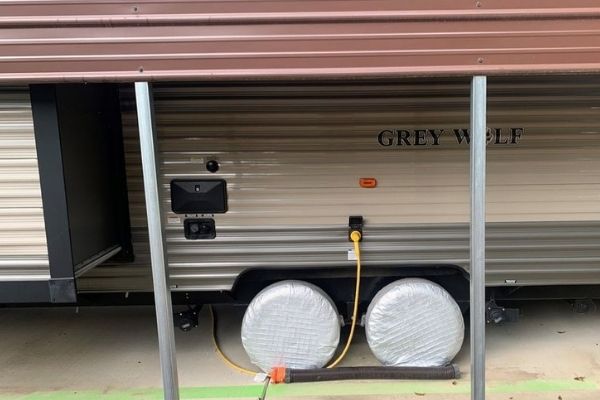
The smell of gas should never be present in your toy hauler. If you can smell gas then you have an issue that needs to be fixed. Not only are gas odors unpleasant and capable of making your trip miserable, but they also pose fire and health issues if they are not addressed correctly and quickly.

Here we’ll take a look at some of the causes of gas smells, how they can affect you and how you can correct them properly.
Are Gasoline Fumes Dangerous For Your Health?
It certainly can be. The CDC publishes Medical Management Guidelines for Gasoline which outline a long list of possible health effects of exposure to gasoline and gasoline fumes. The health effects will vary depending on the individual, the type, amount, and duration of the exposure. These effects can be as minor as slight skin irritation to as severe as slurred speech, confusion, unconsciousness, coma, or death.

While mild short-term exposure is unlikely to cause serious medical issues, repeated chronic exposure even at low levels can lead to problems. If you smell gasoline in your toy hauler it is imperative that you locate the source of the odors and correct them as soon as possible.
Can Gasoline Fumes Ignite?
Gasoline fumes can ignite, but in most situations it is unlikely. According to the CDC’s NIOSH Pocket Guide to Chemical Hazards on Gasoline, the lower explosive limit for gasoline is 1.4% and the upper limit is 7.6%. These numbers tell you that the concentration of gasoline fumes in the air must be between 1.4% and 7.6% to combust if an ignition source is present.

If the concentration is below that range then there is not enough gasoline present in the air to propagate combustion. If it is above that range then the oxygen/gasoline ratio is too low to allow combustion to proceed. To give you a perspective of what those concentrations mean we can once again reference the CDC where they point out that humans can typically smell gasoline vapors at around .025ppm, which is equivalent to 0.0000025%.
So just to reach combustion concentration, the gas vapor concentration in the air would have to be 560,000x greater than the concentration necessary to smell it. That doesn’t mean that there’s no danger of ignition. There is one other property of gasoline fumes we have to take into account.
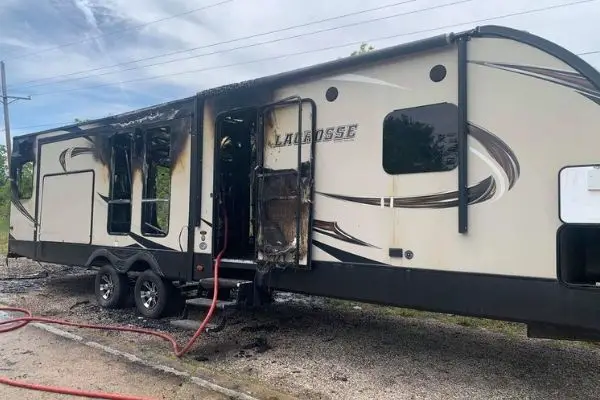
Gasoline fumes are 3 – 4 times heavier than air. This means the fumes tend to spread out from the source along the ground, in many cases over large distances. If you can smell fumes, the source could be a good distance away. While the vapor concentration may not be high enough right at your nose, the likelihood it is high enough will increase the closer you get to the source.

If you’ve ever watched gas burn you can see this. The liquid itself does not burn since the concentration is above the 7.6% threshold. The flames actually occur just above the liquid where the vapors are within that 1.4% – 7.6% range.
Regardless, if you can smell gas assume there is a possibility of ignition and address the issue as quickly as possible.

Can A Toy Hauler Fuel Station Tank Leak Smells Inside The RV?
They certainly can, but a properly installed and maintained fuel station should never leak fuel smells into the RV. If you smell fuel inside your toy hauler and you have established the fuel station as the source then look for a leak, missing cap, or a problem with the tank’s venting system.
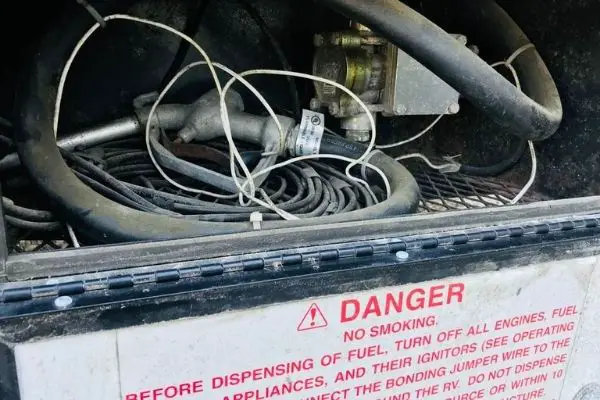
Most tanks will have a vent hose of some sort to prevent pressure buildup within the tank. If so equipped, make sure that the vent hose is properly secured and venting to the outside of the RV.
How Can You Get Rid Of The Smell Of Gas In Your Toy Hauler?
If you have a gasoline odor in your toy hauler there are several things you can do to correct it.
- First, and foremost fix any leaks and clean up any spills. To clean up liquid gas do not under any circumstances try to wash it out with water or suck it up with a vacuum. The former will just spread the fuel around and the latter can lead to an explosive situation. Instead, use a clay based absorbent material like kitty litter, oil-dri or similar products which you can pick up at your local auto parts store. There are also a number of absorbent pad products on the market specifically designed for this application. Gasoline is considered a hazardous chemical so make sure you dispose of the cleanup materials properly per local regulations.
- If the spill has soaked into any porous materials like wood or fabric then getting rid of the smell will take a little longer. The gas will evaporate more slowly from these materials then from harder surfaces. The best thing you can do is increase the clean air circulation around the spill to help the evaporation process along. Wetting the area down with a little white vinegar can help reduce the smell in the short term.
- Gasoline is a very volatile material, meaning that it evaporates easily at normal room temperatures. Once all the spills and leaks are corrected, ventilate the area as well as possible and the fumes will eventually go away on their own.
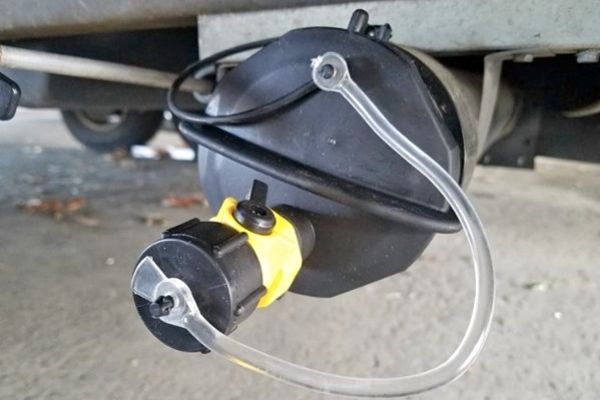
How Do You Prevent Your Toy Hauler From Smelling Like Gas?
There are several things you can do to keep your toy hauler from smelling like gas.
- Keep up on your proper maintenance of the toy hauler and all the toys you carry in it.
- Never park, store or transport a toy in your toy hauler with a known fuel leak.
- If a leak or spill does occur, clean it up immediately and ventilate the area until the odors dissipate
- Always fuel your toys outside.
- Check your fueling station tank venting. All vent hoses should be properly secured and vented outside.
- Always make sure the fuel caps on your toys parked in the garage, as well as your fueling station are properly installed and tightened down.

How To Best Use Air Vents In A Toy Hauler? (Garage Vents)
Most toy hauler garages have a special set of side vents for venting fumes out of the garage. These vents can open forward or rearward. There are a number of ways to use these vents to their maximum efficiency depending on your current situation.

- When sitting or moving in dry clear air, open the forward vents forward and read vents rearward. In this configuration, the forward vent will scoop air and the rear vent will vent air allowing for maximum airflow through the garage.
- When sitting, if the wind is blowing parallel to the trailer then open the upwind vent toward the wind and the downwind vent away from it. Again, this will maximize airflow through the trailer.
- When moving in the rain or dusty conditions, open all the vents toward the rear. This will minimize dust and water intrusion into the garage.
- If you have a covered roof vent in the garage you can leave that open while traveling with the side vents open rearward. The side vents will create vacuum and circulate air in through the roof vent.
Can You Add More Garage Vents In Your Toy Hauler?
More garage vents can easily be added but there are several things you will want to consider before jumping into this project.

- First and foremost, adding vents will require cutting holes through the exterior walls of your RV. If your RV is still under warranty this will almost certainly void that warranty. In that case, contact your manufacturer or an authorized dealer to find how you can have them installed without voiding the warranty. It may cost a bit more, but could end up saving you big if you run into a warranty issue down the road.
- Cutting holes through the wall certainly involves risk. Cut in the wrong spot and you could sever critical wiring, duct work, wall studs or other hidden infrastructure which could be difficult and/or expensive to repair. Don’t cut your walls unless you are absolutely certain it is safe to do so.
- Also, cutting holes in the walls introduces a water intrusion risk. Don’t start the project unless you are certain you have everything necessary to complete it while keeping it dry.
- If you are not confident in all the above then it’s best to leave this job to a pro. It will cost more but it’s a small investment in a project that could create expensive problems if not done correctly.
The next issue is placement. Since gas vapors are heavier than air the best vent placement to remove those vapors will be near the floor. It is also important to space the vents out so that airflow throughout the entire garage space is maximized. Adding vents near the floor, one at either end of the garage would be the best option.

The placement of additional vents can also be influenced by the location of existing factory-installed vents. If your toy hauler already has low vents front and rear in the garage, then adding corresponding high vents would be a good option. If you have a high/low combination then consider adding the opposing pair. This would increase overall airflow through the area and vent the space much faster.
Garage Side Vents VS Roof Vents: Which Moves More Air?
The two types of vents work differently to vent air from your toy hauler so which one moves more will depend entirely on the situation. Since the roof vent is located at the highest point in the garage, it will be better at moving air on a hot day when no air is moving outside.
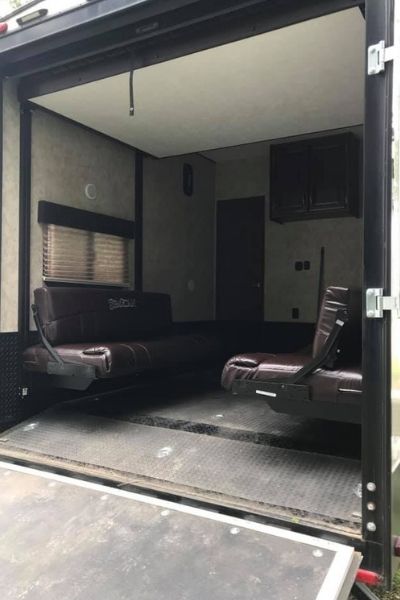
The heat of the day will warm the inside of the garage and the rising air will vent out the roof, drawing cooler air in from the outside. If the wind is blowing, or the toy hauler is moving then the side vents will do a better job venting than the roof vent. This is especially true if you have them facing in the proper direction to allow the wind to flow through the vents/garage.
Roof vents differ from side vents in two other ways.
- Roof vents can include a forced air fan. These fans are reversible so you can force air in, or draw air out of the garage. Standard equipment fans usually offer pretty small air flow values, but replacing them with a high-performance fan is a simple DIY project. High performance fans move a lot of air and can help vent your garage very quickly, even on a calm day.
- Roof vents can also be equipped with AC supports and electrical connections for installation of an AC unit. The side vents cannot. With an AC installed, the roof vent will no longer vent efficiently to the outside, but will work well to keep your garage comfortable.




